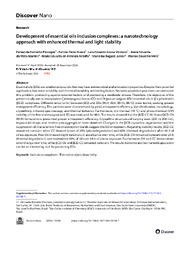Development of essential oils inclusion complexes: a nanotechnology approach with enhanced thermal and light stability.
Development of essential oils inclusion complexes: a nanotechnology approach with enhanced thermal and light stability.
Autoria: PROCOPIO, F. R.; BREXÓ, R. P.; VITOLANO, L. E. S.; MARTINS, M. E. da M.; ASTOLFO, M. E. de A.; BOGUSZ JUNIOR, S.; FERREIRA, M. D.
Resumo: Abstract Essential oils (EOs) are volatile compounds that may have antimicrobial and antioxidant properties. Despite their potential application, low water solubility and chemical instability are limiting factors. Nanoencapsulation processes can overcome this problem, protecting against external factors and promoting a moderate release. Therefore, the objective of the present study was to encapsulate Cymbopogon citratus (CC) and Origanum vulgare (OV) essential oils in ?-cyclodextrin (?CD) complexes. Diferent ratios (w/w) between ?CD and EOs (96:4, 92:8, 90:10, 88:12) were tested, seeking greater entrapment efciency. The particles were characterized by yield, entrapment efciency, size distribution, morphology, crystallinity, infrared spectroscopy, and thermal behavior. Furthermore, the thermal (70 °C) and photochemical (UV) stability of the free and encapsulated EO was evaluated for 48 h. The results showed that the ?CD-CC 90:10 and ?CD-OV 90:10 formulations presented greater entrapment efciency. Crystalline structures of varying sizes (200 to 800 nm), trapezoidal shape, and tendency to aggregation were obtained. Changes in the ?CD crystalline organization and the suppression of characteristic free oil absorption bands suggest the EO entrapment. Regarding stability results, ?CD-CC remained constant when CC showed losses of 20% (photodegradation) and 60% (thermal degradation) after 48 h of stress exposure. Free OV showed slight variations in absorbance over time, while ?CD-OV remained constant over 24 h (thermal degradation) and maintained 60% of oil over 48 h of photo exposure. Furthermore, OV and CC demonstrate color change over time, while ?CD-OV and ?CD-CC remained constant. The results demonstrate that nanoencapsulation can be an interesting tool for protecting EOs.
Ano de publicação: 2025
Tipo de publicação: Artigo de periódico
Unidade: Embrapa Instrumentação
Palavras-chave: Bioactivity, Inclusion complexes, · Thermal analysis
Observações
1 - Por padrão são exibidas publicações dos últimos 20 anos. Para encontrar publicações mais antigas, configure o filtro ano de publicação, colocando o ano a partir do qual você deseja encontrar publicações. O filtro está na coluna da esquerda na busca acima.
2 - Para ler algumas publicações da Embrapa (apenas as que estão em formato ePub), é necessário ter, no celular ou computador, um desses softwares gratuitos. Sistemas Android: Google Play Livros; IOS: iBooks; Windows e Linux: software Calibre.
Acesse outras publicações
Acesse a Base de Dados da Pesquisa Agropecuária (BDPA) para consultar o acervo completo das bibliotecas da Embrapa.

